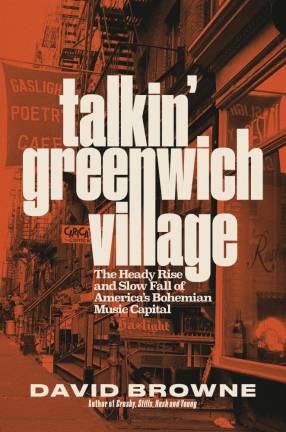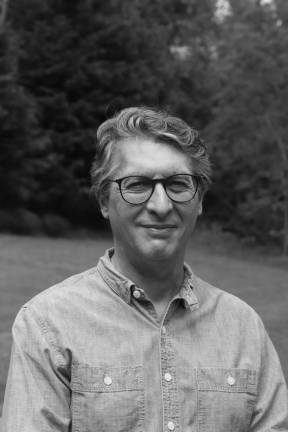“Talkin’ Greenwich Village” Captures The Coolest Neighborhood in the History of the World


David Browne’s terrific new book, Talkin’ Greenwich Village, is a love letter to that distinctive, quirky, historic stretch of Manhattan, extending from 14th Street to Houston Street and west of Fourth Avenue.
Browne expertly captures the spirit of what has always seemed to me to be the coolest neighborhood in the history of the world. Can you think of another place that actually stands for something, as the Village represents artistic, creative and utterly New York posture?
The Village–calling the area Greenwich Village is as hicksville as labeling Sixth Avenue “the Avenue of the Americas”–almost seems mythic, in Browne’s telling. Early on, not long after the end of World War II, it became a haven for, as Browne lovingly writes, “misfits.” These are intelligent people who didn’t fit anywhere else in town, especially on the Upper East Side or in Midtown Manhattan.
Browne, who came to the neighborhood in 1978 as an NYU freshman, is the perfect journalist to chronicle the Village. He is a sensitive but not starstruck observer, who finds equal fascination in the rise of the place’s mystique as in its sad, but perhaps inevitable, decline. Inevitable, yes. Even if the Village has not changed in its standing as a haven for artistic people who weren’t obsessed with financial gains, the city and the world became fixated on capitalism and the Village inevitably seemed more quaint than vital.
Even ancient Rome had its fall.
My Back Pages
Browne is correct, too, to assign such importance into the West Village. I also have roots there. I arrived at my first Manhattan apartment at 101 West 12th St., on Sixth Avenue, in January 1980. It was nothing less than thrilling to settle in Greenwich Village. Of course, I quickly got into a Villagey routine. I often stayed out all night, looking for action and memories (frequently in the company of the editor of this web site and newspaper!). While, looking back on it objectively and clear eyed, nothing extraordinary actually happened. But I still remember the excitement of prowling those pulsating, narrow streets.
The centerpiece of the Village, then, was the music scene, or what was left of it after Bob Dylan left and triggered the End of the Excitement for a lot of people.
The Mayor of MacDougal Street
Browne deftly avoids the temptation to this volume into a tribute to Bob Dylan. Even though effectively relocated from New York City to Woodstock in the mid-1960s, he remains the Village’s greatest symbol and ambassador.
But Village historians regard Dave Van Ronk, the folk singer who preceded Dylan and was nicknamed the Mayor of MacDougal Street, was the real deal.
Van Ronk, who died in 2002, was five years older than Dylan and mentored Dylan when he arrived in the Village utterly unceremoniously in January 1961.
Van Ronk’s historical importance in Village annals is similar to the lofty position that Hank Williams occupied in Ken Burns’ excellent documentary series on folk music.
It would have been easy for Browne to paint Van Ronk in the same unflattering light that Coe did too. Browne includes Brothers seemed to employ in their well-made but roundly criticised film about a Van Ronk symbol in the early 1960s Village music scene, Inside Llewyn Davis. The movie featured a searing performance by actor Oscar Isaac as the Van Ronk-tinged character.
Of course, Dylan forever put his stamp on the Village. Browne includes a fascinating glimpse of Dylan just before he arrived in the Village and was hanging out at the University of Wisconsin in Madison.
Writes Browne: “When [Badger student Fred] Underhill announced that he and some friends would be driving his Pontiac to New York, Dylan tagged along, entering the city in the third week of January 1961. New York had been slammed with a thunderstorm, but nothing would stop him from making a first impression.”
That brief description removes some of the glamour from previous accounts of how Dylan arrived in New York. Others make it sound like Dylan was on a mission to come to the city, meet his hobbled idol Woody Guthrie and set the world on fire in a well thought out plan that neatly revealed Dylan’s destiny as a folk-music revolutionary.
Historian
Among its accomplishments, Talkin’ Greenwich Village is as much of a book about a segment of the history of the city as the folk music revolution.
In an era when there is a Starbucks or a CVS seemingly on every block in Manhattan, it is a pleasure to be able to remember a time when individual style was celebrated, and success was not always measured in terms of someone’s affluence.
This book should be required reading in history courses that focus on New York City. It would offer than a nostalgic look at a bygone time. It would also help today’s students understand how we got here.
Veteran journalist Jon Friedman teaches a course about Bob Dylan at Stony Brook University and is the author of “Forget About Today: Bob Dylan’s Genius for (Re)Invention, Shunning the Naysayers, and Creating a Personal Revolution” (Perigee, 2012).
